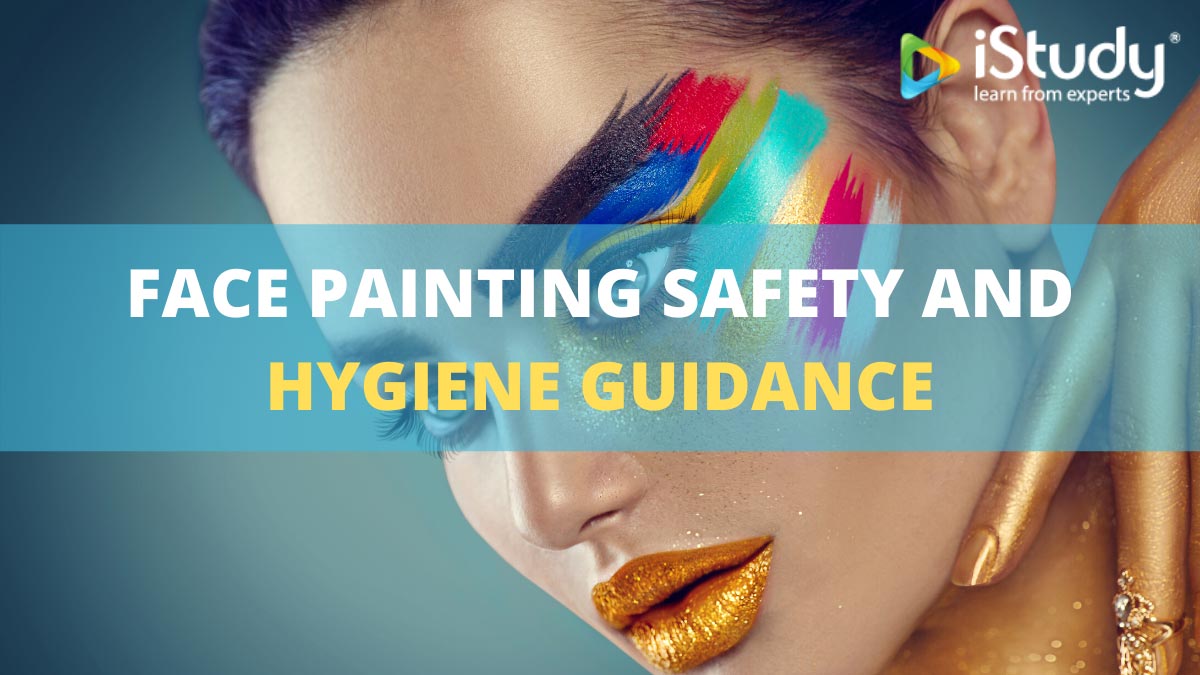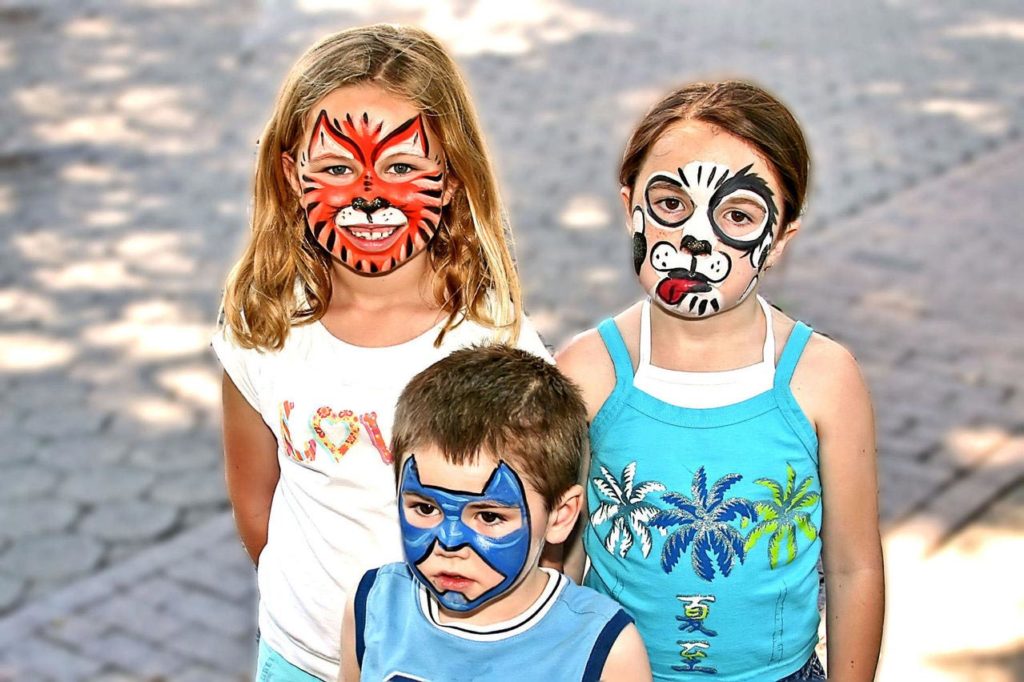
Your kids’ birthday coming up, you have ordered the cake, arranged the decorations, bought the toy he has been nagging for the past 2 months as a birthday gift, and invited his friends of course.
Wait, aren’t you forgetting something?
Yes, you haven’t hired a face painter yet to make this party really going! So you hire up local talent, supposedly good with paint jobs.
Now, let’s observe a scene from the perspective of the face painter.
You got the gig, went to do your job, painted on demand colours on a bunch of kids all day. Just as you are finished and packing up, one of the parents comes running at you, yelling that you caused her son an allergic reaction.
In your mind, “no way!” Then you check out the kid to find out, he might be allergic to the paint you used. What a disastrous way to end a cheerful day, right?
Only if you were a little more professional and had a better idea about face painting safety guidelines, this whole disaster could have been avoided!
Why is face painting so popular and demanding?
Face painting and body painting can be traced back to the indigenous people of Australia and Africa. Since then, it has been considered to serve many purposes. From part of religious or cultural practices to as functional paint like camouflaging military personnel or sports paint. It has also served as a form of art or artistic expression.
But in the recent decade, the face painting activity has grown to be popular as a form of entertainment, be it for Birthdays, Halloween parties, or in a Fundraising Event. Not only children, but the grown-ups enjoy this fun activity too.
With its increasing popularity, the concern for face painting safety and hygiene grows too.

In this article, we will discuss the hazards you may face as a professional and the face painting safety guidelines you must follow to make this entertaining activity safe and fun as it should be.
Is face painting safe for your kids?
According to a report on Heavy Metals in Face Paints by the Campaign for Safe Cosmetics, upon lab testing 10 face painting products, they found all of them are contaminated with lead to various degrees, and some products contained metals like nickel, cobalt, and chromium.
These metals can be especially lethal for your children if non-cosmetic grade paint products are used. The lead can hamper the development of your child’s brain, while the other metals found can cause serious skin damage.
Apart from these, the following health hazards can occur if appropriate measures and precautions regarding face painting safety guidelines are not practised.
- Allergic reactions and rashes owing to chemical compounds from non-cosmetic grade products.
- Bacterial infection due to the lack of hygiene measures.
- Skin and eye damage by paint-brush, paint materials, or unsuitable glitters.
- Cross-contamination and spread of contagious diseases from one child to another.
- Damage to sensitive or already injured skin due to exposure to unhygienic and unregulated paint materials.
10 Professional Safety and Hygiene Tips for Face Painting
1. Learn the “Face Painting Regulations” in the UK
First things first, you must know the existing legal rules and regulations of face painting safety guidelines, just so you don’t end up somewhere you don’t belong unintentionally.
Make sure you understand and abide by the Cosmetics Regulation (EC) No. 1223/2009 implemented by trading standards in the UK by Cosmetic Products Enforcement Regulations 2013.
What happens when you don’t comply with the Face Painting Regulations?
If found of foul play, you can be convicted with a fine up to £20,000 and/or up-to 12 months of imprisonment!
2. Use the right paints
You can often be misconstrued by the “non-toxic”, “washable” labels on the paint. While non-toxic doesn’t necessarily mean they are suitable for skin, the washable label is most likely meant for fabrics. They can do serious damage, especially to sensitive children’s skin.
- Use only cosmetic grade paints compliant with EU regulations.
- Do not apply Acrylic craft paints, watercolours, or markers on the face.
- Use water-based paints only, so the children can remove them easily afterwards.
- Consider hypoallergenic paints for sensitive skin.
- For glitters, use polyester made ones with a cosmetic size of .008 microns or smaller.
- Always check for the expiration date on your paints before you head to your gig.
While you can buy the most child-safe face paint products from Amazon or eBay, you can also check out the following shops based in the UK for authentic cosmetic grade paints and other materials.
Face paint UK | Face Paint Supplies | Paintopia | Glitter and Pop | Webster’s Face Paint | Face Paints Direct | Illusion Face Painting Store | The Face Painting Shop | Magic Box Face Paints.
3. It’s crucial that you pick appropriate tools
For those who are just starting out in face-painting, it is important to understand that just as the paints you would be using, the brush, sponge and other materials also should be skin sensitive. Rough or edgy materials can ruin this fun activity for the kids and hamper your reputation as a growing professional.
- Pick skin appropriate brush made with materials considering the sensitiveness of children’s skin.
- Only use fresh sponges, you don’t want to give a child rash or scratch with your sponge.
- Bring enough towel, drinking and cleaning water, baby wipes, sanitizers with you to go through the session.
- Bring a mini bin to put your used sponges, Q-tips and wipes.
4. How to clean your face painting kits
Different painters use different methods in cleaning and sanitizing their tools. Some painters feel hot water is adequate, while vinegar dip or cleaning with isopropyl alcohol is also a popular practice among the professionals. However, the following standards should always be maintained.
- Upon every use, clean the brushes, sterilize them, and rinse them properly. Always disinfect them after the event.
- Never use the same sponge twice. Since the sponge material is porous and has a larger contact area, it is not safe to use multiple times.
- Use fresh and clear water. Change the water you use for cleaning tools frequently.
- Use multiple bowls or cups to clean your tools, so it is easier for you to change them.
Check out how Stacy Parzik, a professional face painter goes over her cleaning process around concerned parents in a birthday party.
5. Personal hygiene practices for the painter
The first rule of basic hygiene is good personal hygiene. As a painter, you must be aware of this and incorporate basic hygiene practices. While on a gig, you should take the following cautionary measures.
- Wear appropriate, clean clothing to the gig. You don’t want to risk cross-contaminating the kids or scare them away with your sleazy look.
- Wash your hands properly before and after every paint-job. Bring hand sanitizers and alcohol-based wipes to the job.
- If you are sick with a cold fever or any contagious disease, do not perform in any event.
- Clean yourself up properly after completing the job to make sure you don’t carry any contagious diseases with you to your home.
- Ask the parents or the client about any health concerns you might need to know about.
6. Health consideration of client
Paint products are basically chemicals, some of them could cause excruciating pains to children if in contact with eyes or an open wound. Some children could be allergic to paints and often be troubled with serious anguishes. Make sure you check the following boxes on your face painting safety guidelines list before and during the paint-job.
- Check with the parents if the child has any kind of allergy.
- Check if there is an open wound, acne, or cold sores on the face. Do not paint if these exist.
- Check if the client is suffering from any sickness or contagious disease.
- Take consent from both the parent and the child before doing the paint.
- Avoid painting kids below 3 years old.
Diploma in Graphics Design
👉 1 - to - 1 Mentoring
👉 Full Tutor Support
👉 8 Interactive Live Classes
👉 Chance to Win Chromebook
👉 3 CPD Accredited Course Free
Diploma in Graphics Design
👉 1 - to - 1 Mentoring
👉 Full Tutor Support
👉 8 Interactive Live Classes
👉 Chance to Win Chromebook
👉 3 CPD Accredited Course Free
7. Caution in application
During painting on the face, you can often cause fatal injury, especially while working on a restless child. Because kids are kids, and they get bored easily and don’t like to stay still. You don’t want to end up slipping the brush and hurting his eye in a bad way.
- Cover the eyes of the client with your hand or a clean towel while painting around the eyes.
- Do not paint glitters in proximity to the eyes, ears and nostrils.
- Make sure you there is no water pool on the face, in case they drip into the mouth.
- Do not paint the internal part of the lips, use a Q-tip to paint over the outer part.
- Do not perform the paint job if the child does not want to.
- Ask the parents to stay around in case the child is afraid or restless.
8. Safety guidelines in removing face paints and stains
After putting up face paints with such an elaborate process, not many would think much once their purpose is served to remove them. But it is equally important to take some cautionary measures while removing face paints. Especially if the client is a child, and he attempts to do so on his own once the party is over.
How to remove paint from skin naturally?
The most common and effective home-made remedies to remove face paints naturally is using coconut oil or olive oil.
The advantage of natural paint remover is that they are less likely to cause any irritation on your skin or instigate any damage. Although, it will take some rubbing to get rid of the paintings properly.
(How to Remove Face Paint Stains From Your Skin, Tutorial by TeaIs For Teagan)
Other common ways to remove face paints
Soap and water will do just fine to remove most water-based paints. However, the stains will require some work to get removed properly. Oil-based makeup removers and wipes, micellar water or shampoos are also commonly used to remove paint stains.
To learn more about paint removal, check out this link.
9. A comfortable and safe workspace
It is important for the child to feel they are in a safe zone. And the workspace should be organised in a way that it doesn’t cause any stress-related injuries.
- Make sure the sitting arrangement is comfortable for both you and the client.
- Arrange the tools and paints in such a way that they are in reach of your hand, yet they are not obstructing your movements.
- Avoid doing too many twists and turns, try to keep your back straight for most of the time.
- Take a break every once in a while to get some stretching done and drink some water.
10. Consider an insurance policy
The idea of spending your hard-earned money for something that hasn’t happened and it may not even occur ever might take some convincing to wrap your hand around it. So, let’s elaborate.
Accidents happen all the time, even when you are super-cautious and at your best. Because life is unpredictable, this fact is much more relevant when most of your clients are children.
An allergy you weren’t warned about, a tiny fine stroke of brush slipping around the eye area while working on a restless kid, some chemical reaction occurring way after the job is done. You can be prepared for these things, but can not always dictate the outcomes. This is where a manageable insurance policy comes to play, which won’t cost you an arm and leg and will be worth every penny you had spent on them.
You can check out with your local insurance providers or the following UK based agencies who provide insurance coverage for face painters.
There are also some internationally recognised agencies who take insurance responsibilities, such as FACE (The International Face Painting Association), World Clown Association, and AXA.
Many of them might require you to be a member with recognised credentials supporting your skills. Their membership naturally means increasing the chance to get hired for more gigs.
Even if it is not an obligation in every county or city, being insured is the sensible and professional thing to do as your business grows.
Conclusion
Like any other fun activity, there is no two-way about being educated on the face painting safety guidelines when there is so much at stake to lose. Equally important for the parents to understand the risks and take appropriate measures without taking the fun part away.
As for the painters out there, to excel in your career, you must know all the in’s and outs of your trade better to provide risk-free entertainment and grow as a professional.
Check out our other painting courses:
- Modern Acrylic Painting: Explore Techniques to Create On-Trend Art
- Modern Watercolour Techniques: Explore Skills to Create On-Trend Paintings
- Painting and Decorating Diploma
- New & Easy Colour Mixing for Painters – in Acrylic & Oil
- Watercolour painting beginner foundation course how to paint
- Drawing Human Actions to Master Figure Drawing and Painting
- Professional Diploma in Canvas Painting
- All Courses
- Technology64
- Business268
- Language50
- Marketing126
- Photography22
- Software55
- Security Guard2
- Coaching5
- Maintenance Management23
- Bundle6
- Ex Deal54
- Business,Personal Development3
- Networking & Design6
- IT29
- Health & Safety91
- Cooking9
- Physical & Mental Health21
- Treatment9
- Photoshop3
- Child care23
- Parenting1
- Leadership & Management1
- Fast Track210
- Teaching & Education9
- International Relations2
- Philosophy1
- Office Skills2
- Health & Fitness2
- Health and Care17
- Law2
- Animal Care12
- Accounting & Finance6
- IT & Software3
- Management232
- Microsoft Office134
- Design68
- Travel and Tourism8
- Beauty20
- Accounting42
- Employability247
- Sports, Nutrition & Fitness200
- HR and Leadership58
- Personal Development477
- Autism2
- Customer Service6
- Nursing & Care82
- Lifestyle22
- Teacher Training28
- Project management3
- Mathematics7
- Counselling and Therapy52
- Psychology28
- Pharmacy5
- Animal1
- Development10
- Arts & Crafts19





45 responses on "Face Painting Safety and Hygiene Guidance"